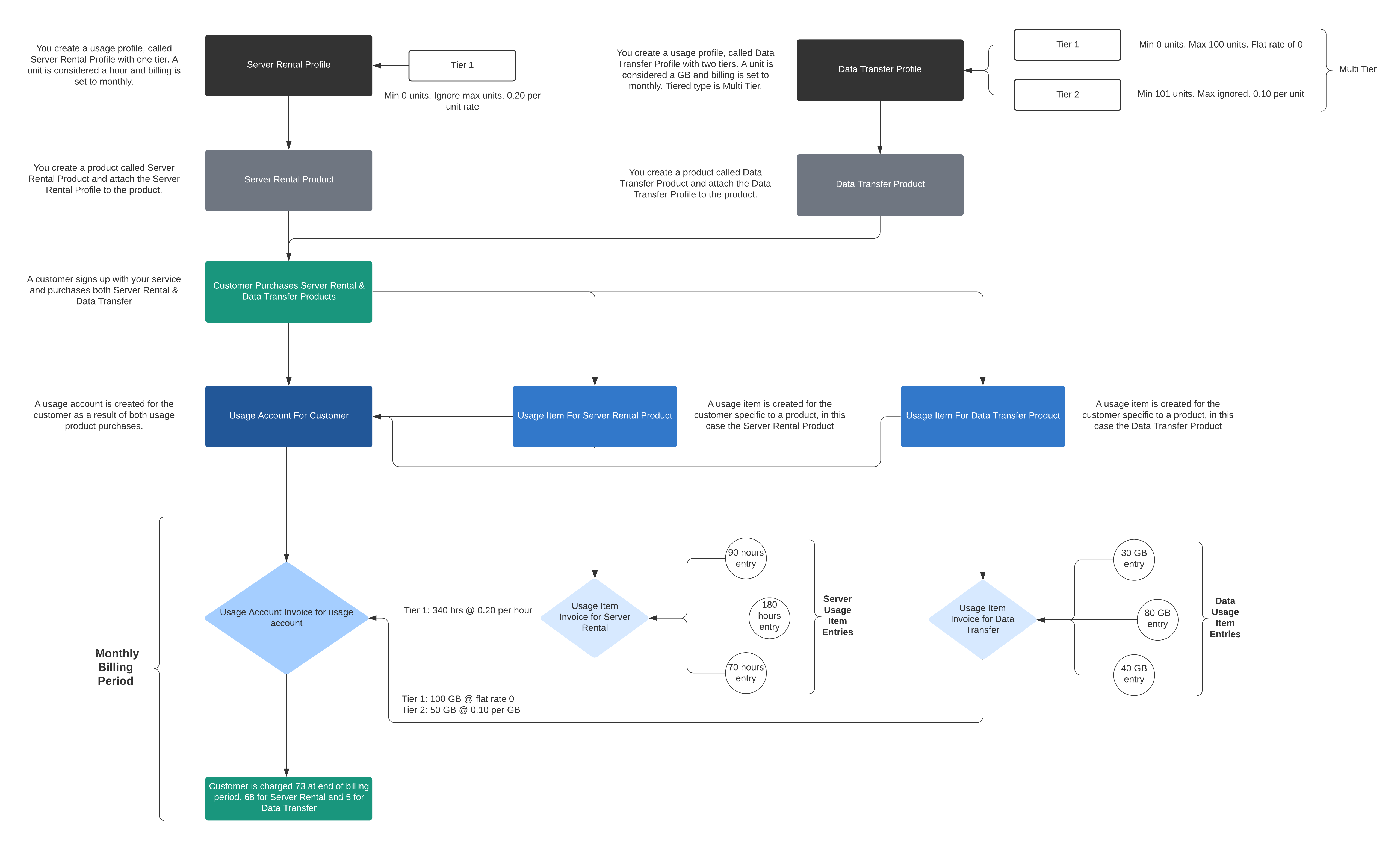¶ Usage & Metered Billing
RevCent supports usage billing, also known as metered billing. Create an initial sale containing one or more usage based products and utilize our web app or API to track usage and automate billing. RevCent calculates the amount to charge at the end of a billing period based upon the usage profile and usage amount during said billing period.
¶ Feature Is Disabled
Usage and metered billing has been disabled for new users created after 12/01/2021. This does not affect existing users using this feature prior to 12/01/2021. We apologize if you wish to use our usage and metered billing. At this time we do not have the ability to support the time consuming implementation process required for new users given the high learning curve necessary with this feature.
¶ Before You Proceed
Linking the customer ID in RevCent with your internal customer is essential. Usage & metered billing requires that you know which one of your customers are actually conducting the usage. You of course don't want to bill one customer for another customers' usage. Therefore, you must have some form of an identification mechanism internally on your end to discern customers from one another with their associated customer ID in RevCent.
¶ Core Concepts
Usage Profile: This is created by you. A usage profile is created by you within RevCent and determines the billing period duration, i.e. every 7 days, every 1 month, etc. The usage profile also determines the pricing for specific usage. Pricing can be flat rate, fixed per unit or tiered with each tier being a variable per unit or fixed pricing based upon the total usage. You attach a usage profile to a product, and when a customer purchases the usage product several entities are automatically created specific to the customer.
The reason for attaching a usage profile to a product is so that when the product is initially purchased by a new customer, RevCent knows to automatically create a usage account and usage item for the new customer. The initial product purchase is an onboarding mechanism used to create the necessary usage entities specific to a new customer for their future usage billing. Once a customer has made the initial purchase and has a specific usage item, you will automatically bill them for usage by referring to their specific usage item.
Usage Account: This is automatically created by RevCent. A usage account is created when one or more usage products is initially sold. The usage account is specific to a customer and contains the usage items created, each usage item being the usage product sold initially sold.
Usage Account Invoice: This is automatically created by RevCent. Each usage account has a usage account invoice automatically created for each billing period. Usage account invoices contain one or more usage item invoices, each item invoice having the same billing period but potentially different pricing based on the usage profile for a product sold.
Usage Item: This is automatically created by RevCent. Each usage product sold automatically creates a usage item specific to the customer, which is attached to the specific usage account for the customer. The usage item is the entity used to create usage item entries in order to track usage.
Usage Item Invoice: This is automatically created by RevCent. Each usage item for a usage account has a usage item invoice for the billing period duration specified by the usage profile. The usage item invoice calculates the amount to charge a customer based on the pricing settings in the usage profile and the usage item entries created during the respective billing period. A usage item invoice is a child entity to the usage account invoice, the usage account invoice being the entity being used to charge the customer for a specific billing period.
Usage Item Entry: This is created by you. A usage item entry tells RevCent whether to increase or decrease a customers' usage for a specific usage item and its invoices' billing period. You can use our web app or API to create a usage item entry. By default, when sending a usage item entry to RevCent, the entry is assigned to the usage item invoices' current active billing period, however you can specify a prior invoice if needed.
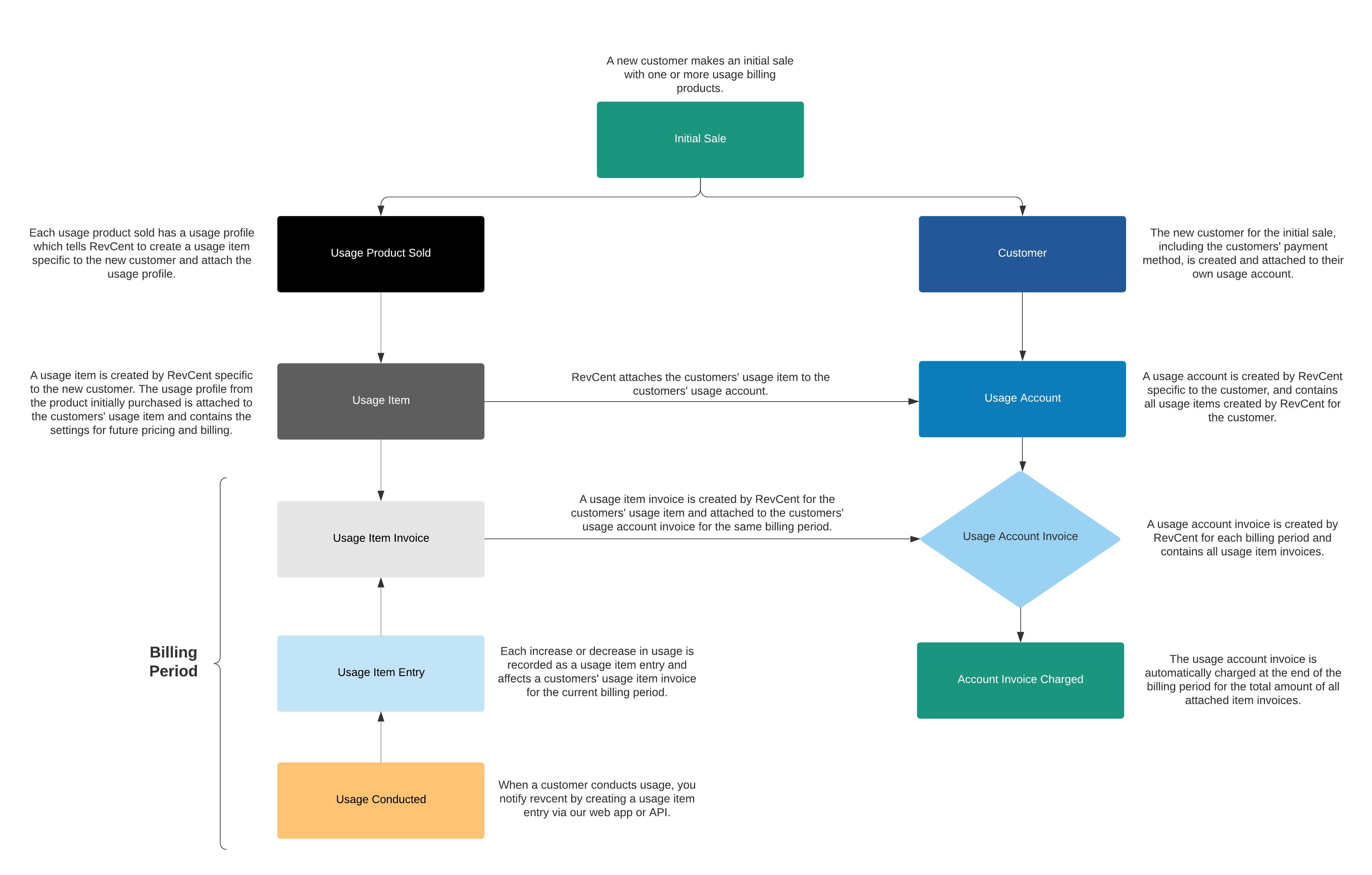
¶ Usage Profile
Created by you
A usage profile is created by you within RevCent and determines the billing period duration, i.e. every 7 days, every 1 month, etc. The usage profile also determines the pricing for specific usage. Pricing can be flat rate, fixed per unit or tiered with each tier being a variable per unit or fixed pricing based upon the total usage. You attach the usage profile to a product(s) that you wish to be usage based products.
Important: The reason for attaching a usage profile to a product is so that when the product is initially purchased by a new customer, RevCent knows to automatically create a usage account and usage item for the new customer. The initial product purchase is an onboarding mechanism used to create the necessary usage entities specific to a new customer for their future usage billing. Once a customer has made the initial purchase and has a specific usage item, you will automatically bill them for usage by referring to their specific usage item.
View all usage profiles by clicking Revenue > Usage > Profiles in the sidebar or go to https://revcent.com/user/usage-profiles
¶ Create/Edit A Usage Profile
Create a new usage profile by clicking the Create New Usage Profile button when viewing all usage profiles or go to https://revcent.com/user/new-usage-profile
Edit an existing usage profile by clicking the edit button when viewing all usage profiles. You can also clone an existing usage profile by clicking the clone icon.
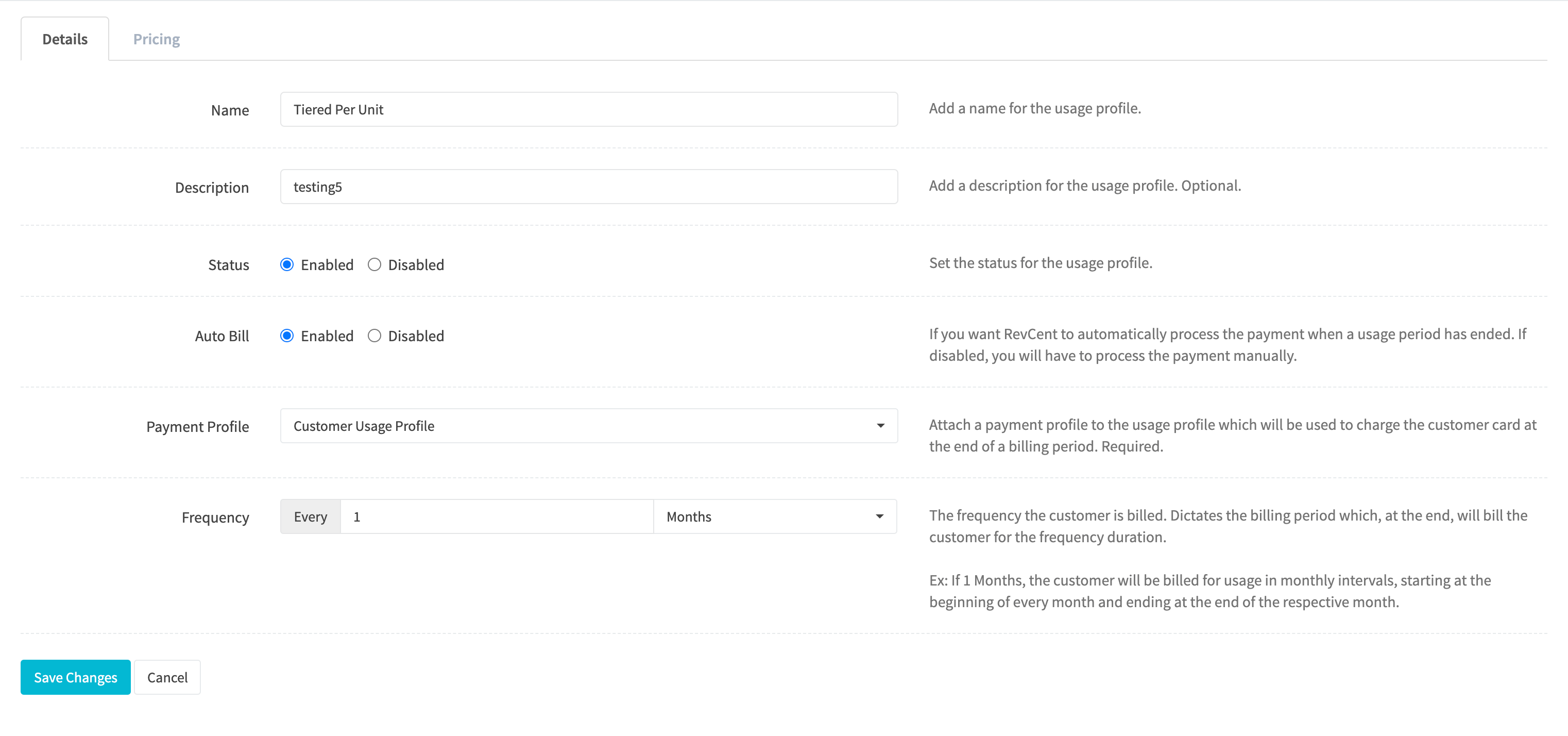
¶ Profile Details
¶ Name
Enter a name for the usage profile. Required.
¶ Description
Enter a description for the usage profile.
¶ Status
Set the status of the usage profile.
¶ Auto Bill
If you want RevCent to automatically process the payment when a usage period has ended. If disabled, you will have to process the payment manually.
¶ Payment Profile
Attach a payment profile to the usage profile which will be used to charge the customer card at the end of a billing period. Required.
¶ Frequency
The frequency the customer is billed. Dictates the billing period which, at the end, will bill the customer for the frequency duration.
Example:
If Every 1 Months, the customer will be billed for usage in monthly intervals, starting at the beginning of every month and ending at the end of the respective month.
¶ Profile Pricing
The usage profile pricing is the most important part of the RevCent usage & metered billing system. The pricing for a usage profile specifies the method for calculating totals, the amount to bill and separate billing tiers.

¶ Billing Type
The billing type for the usage profile.
Options:
- Per Unit: Customer is billed a flat per-unit cost without tiers. Customer cost = total units * unit cost.
- Flat Rate: Customer is billed a fixed amount per billing period, regardless of actual usage. Customer cost = fixed amount.
- Tiered: Customer is billed via tiers, each tier having a cost and a unit range. View the tiered billing section below.
¶ Tiered Billing
Tiered billing allows you to customize the exact amount to charge your customer based on a specific number of units. Create as many tiers as you want and customize each tiers' pricing. Also, create notifications for a specific tier, allowing you to email the customer given usage cost or units consumed. When selecting tiered billing you will need to select the tiered type.
¶ Tiered Type
- Single Tier: Calculate billing amount based on total usage and tier cost for the final tier that total usage is within tier constraints. Customer Cost = Cost from one tier.
- Multi Tier: Calculate billing amount based on usage and tier cost for each tier that usage is within tier constraints. Customer Cost = Cumulative cost across applicable tiers.
¶ Individual Tier
Add a tier by clicking the Add Tier button. Each additional tier begins its unit from the end of a prior tier, i.e prior max + 1.
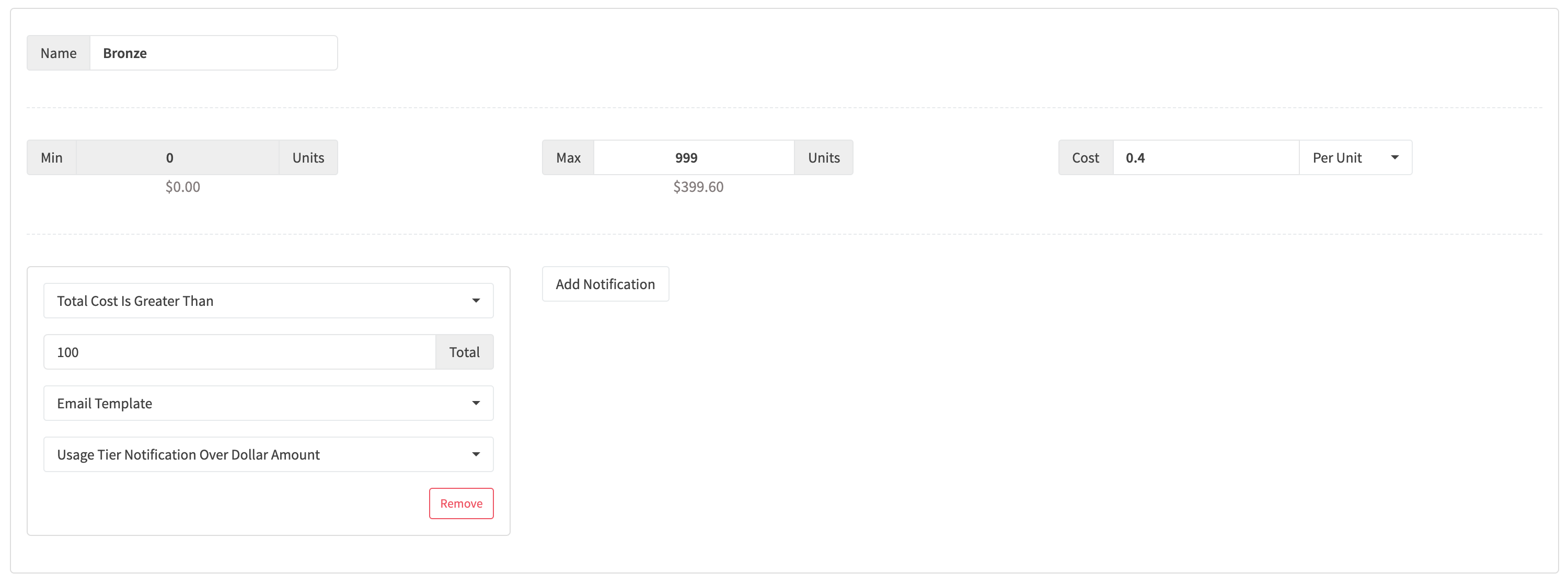
¶ Tier Name
Enter a name for the tier.
¶ Tier Min
The minimum unit will be either 0 for the initial tier, or the next unit from the max unit of a prior tier. I.e. start of tier.
¶ Tier Max
Set the the maximum number of units for the specific tier. I.e. end of tier.
¶ Tier Cost
Set the value and select the type. This determines how much the customer will be charged if usage is within the individual tier.
Type Options:
- Flat Rate: A flat rate to bill, regardless of units consumed for the specific tier.
- Per Unit: The amount to bill per unit for the specific tier.
¶ Tier Notification
Add a custom notification based on the specific tier. You will need to implement a custom Email Template.
¶ Usage Account
Created by RevCent on initial sale
A usage account is assigned to a customer when one or more usage products is initially sold. The usage account is specific to a customer and contains the usage items created, each usage item being the usage based product sold in the initial sale. Each billing period will create a new usage account invoice and the invoice attached to the usage account.
View all usage accounts by clicking Revenue > Usage > Accounts in the sidebar or go to https://revcent.com/user/usage-accounts
¶ Usage Account Details

¶ Usage Account Invoice
Created by RevCent each billing period
Each usage account has an invoice for the billing period, called a usage account invoice. Usage account invoices contain one or more usage item invoices, each item invoice having the same billing period as the parent usage account invoice.
View all usage account invoices by clicking Revenue > Usage > Account Invoices in the sidebar or go to https://revcent.com/user/usage-account-invoices
¶ Usage Account Invoice Details

¶ Usage Item
Created by RevCent on initial sale
Each usage product sold (a product with a usage profile attached) spawns a usage item which is then associated with the usage account for the customer. The usage item is the entity used to create usage item entries in order to track usage. You can notify RevCent programmatically via API when a customer conducts usage as frequently as you want using the usage_item_id property. View more information on how to record usage via API.
¶ Usage Item Details
View all usage items by clicking Revenue > Usage > Items in the sidebar or go to https://revcent.com/user/usage-items
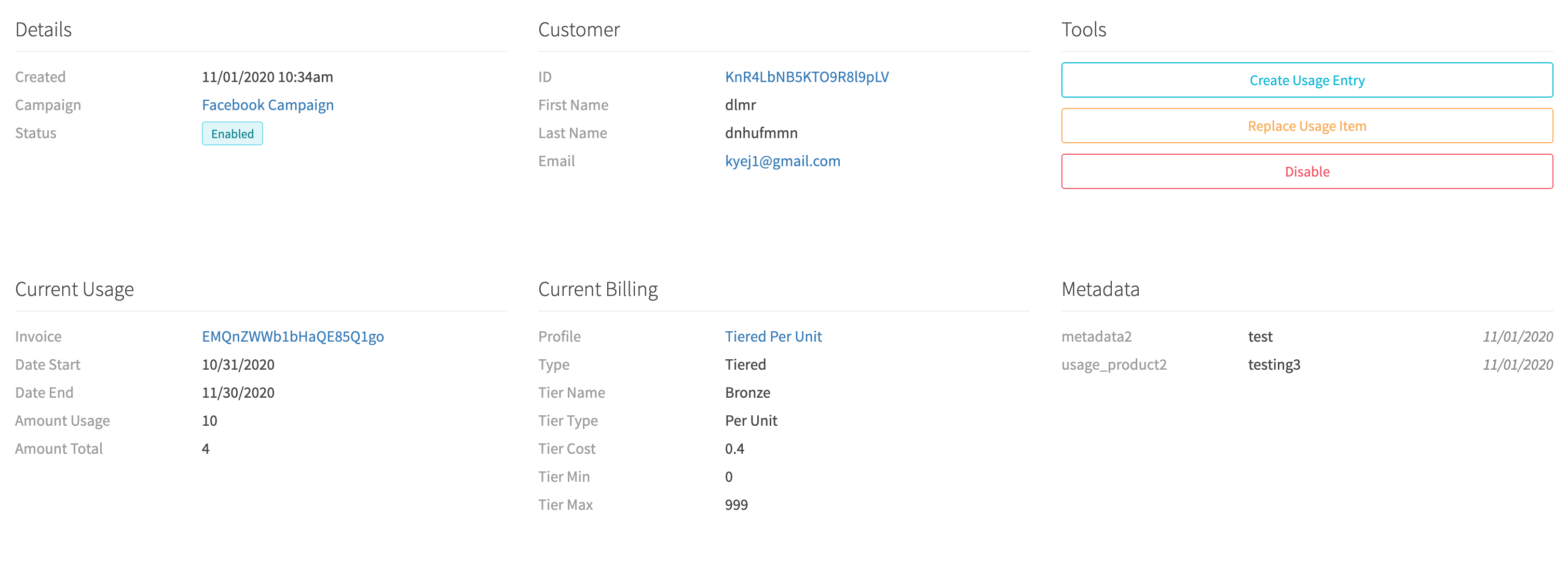
¶ Create Usage Entry
If you wish to manually create a usage entry for the current billing period, click the Create Usage Entry button. View more on creating a usage entry via web.
¶ Replace Usage Item
You can replace a usage item, for example if a customer upgrades their service, by clicking the Replace Usage Item button. This will disable the current item and replace it will a new one.
¶ Disable
If you wish to disable the usage item, not allowing it to record usage or be billed regardless of billing period.
¶ Usage Item Invoice
Created by RevCent each billing period
Each usage item for a usage account has a usage item invoice for the billing period duration specified by the usage profile. The usage item invoice calculates the amount to charge a customer based on the pricing settings in the usage profile and the usage amount entries created during the respective billing period. A usage item invoice is a child entity to the usage account invoice, the usage account invoice being the entity being used to charge the customer for a specific billing period.
View all usage item invoices by clicking Revenue > Usage > Item Invoices in the sidebar or go to https://revcent.com/user/usage-item-invoices
¶ Usage Item Invoice Details

¶ Create Usage Entry
If you wish to manually create a usage entry, click the Create Usage Entry button when viewing the invoice details. View more on creating a usage entry via web.
¶ Disable
If you wish to disable the usage item invoice, not allowing it to be billed at the end of the billing period.
¶ Usage Item Entry
Created by you
A usage item entry tells RevCent whether to increase or decrease a customers' usage for a specific usage item and its invoices' billing period. By default, when sending a usage item entry to RevCent, the entry is assigned to the usage item invoices' current active billing period, however you can specify a prior invoice if needed.
View all usage item entries by clicking Revenue > Usage > Item Entries in the sidebar or go to https://revcent.com/user/usage-item-entries
¶ Usage Item Entry Details

¶ Recording Usage
Let RevCent record each individual usage for you by creating a usage item entry. This reduces the burden of keeping track of usage and calculating the amount to charge at the end of a billing period. Each time you want to record a customers' usage you can use the RevCent API or the web app. With the API you have the option to attach metadata for granular metrics.
¶ Getting The Usage Item ID
It is important to link the usage item ID in RevCent with your internal customer for the specific product they are using. You can get the specific usage item ID and the customer ID in an initial sale response. The reason for retrieving the usage item ID is to be able to discern the specific product being used and the customer that is committing the usage. How you plan to perform authorization and/or identification of what customer, and their usage item, is up to you.
Note: You can also retrieve an initial sale API response using a Webhook endpoint or subscribing to a Websocket.
¶ Initial Sale API Response
Usage Item ID: The initial sale JSON response will contain a usage_item_created array, which contains one or more usage item objects depending on the number of usage product(s) sold. Each object is a unique usage item with an id property. In the example below, the usage item ID is Ya1MA2NPyGcGnNJw0LzM. To view a full non redacted example of an initial sale response, check out our API docs.
Advanced: If you sell multiple usage products in a single sale, utilize the product object within a usage item object to match the product id, or internal_id, for the specific usage item on your end. In the example below, the product ID is MWZKMr82qvs5boW8gbQP with an internal ID of test_usage_product.
Customer ID: You will also find the customer_id property, which is the ID for the customer in RevCent. In the example below, the customer ID is VPwvq5lOkafJwqGVZB5v.
{
...
"customer_id": "VPwvq5lOkafJwqGVZB5v",
"usage_item_created": [
{
"id": "Ya1MA2NPyGcGnNJw0LzM",
"product_sale": {
"id": "nbvP5lpyVLCdZYnbLjAM"
},
"product": {
"id": "MWZKMr82qvs5boW8gbQP",
"name": "Tiered Per Unit",
"internal_id": "Bn7Jk4jWg_internal_id",
"sku": "test_usage_product"
},
"trial": null,
"usage_account": {
"id": "X8bGkvgjNYfbAkl75wQL"
}
}
]
...
}
¶ Create a Usage Item Entry via API
Create usage item entry via the API when a customer conducts usage. In the example below we are assuming that the product is a Phone Usage Plan, with 1 unit equaling 1 minute. When a call is completed, we send the duration in minutes as via the amount_usage property. In the example below we are indicating that the customer used 10 minutes. You identify the customer and the specific product being used via the usage_item_id property. Read more on getting the usage item ID from an initial sale response.
{
"request": {
"type": "usage_item",
"method": "create_entry",
"usage_item_id": "VPRr2zzB0BFMk6KNkQaq",
"usage_method": "increase",
"amount_usage": 10,
"metadata": [
{
"name": "phone_call_id",
"value": "123456"
}]
}
}
¶ API Request Properties
¶ request
The main request object containing the details of the call.
¶ type
The API call type. usage_item
¶ method
The API call method. create_entry
¶ usage_item_id
Important: The usage item ID field identifies the customer as well as the usage product. RevCent needs to know the usage item ID in order to bill the correct customer at the correct amount. When you supply the usage item ID, RevCent knows who the customer is and the product (product has the usage profile attached). The usage item ID is supplied during the initial sale response for the specific product. Read more on getting the usage item ID from an initial sale response.
¶ usage_method
The usage method relative to the entry. increase or decrease
¶ amount_usage
The usage amount relative to the entry. This tells RevCent how much to either increase or decrease depending on the usage_method.
¶ metadata
The metadata property is an array of objects, each object being a name, value pair. This is useful for recording the specific details of the individual usage as well as perform aggregate metrics in your RevCent dashboard. In the example above we attached the phone call ID as metadata, letting us match it with internal call records. You can attach multiple metadata objects for even more detailed information.
¶ Create a Usage Item Entry via Web
You can also create a usage item entry manually via the RevCent web app. View the specific usage item to add usage for the current billing period, or the usage item invoice for the specific billing period, you wish to add a usage entry to. Click the Create Usage Entry button in the Tools column when viewing either the usage item details or usage item invoice details.
¶ Usage Entry Modal
After clicking the Create Usage Entry button a pop up will appear. Select the entry method and enter an amount of units.
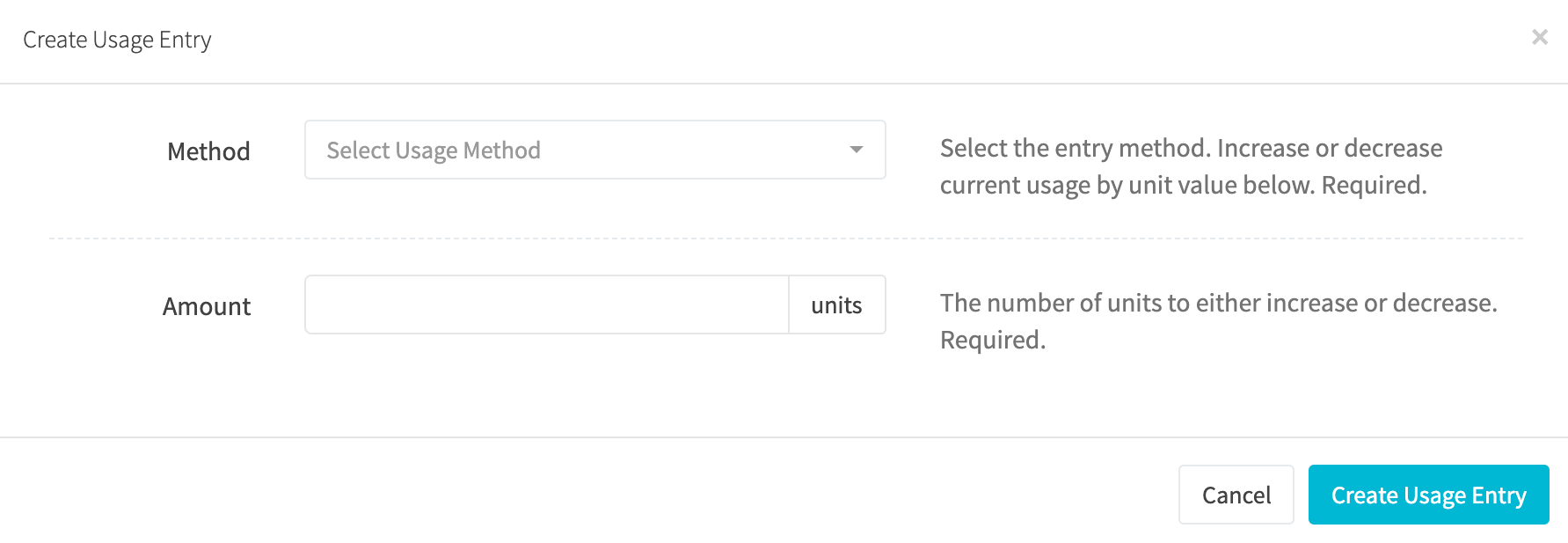
¶ Method
The usage method relative to the entry.
Options:
- Increase: Increase the total usage.
- Decrease: Decrease the total usage.
¶ Amount
The usage amount relative to the entry. This tells RevCent how much to either increase or decrease depending on the method selected.
Once you have selected the Method and entered the Amount of units, click the Create Usage Entry button and wait for the page to reload.
¶ Business Model Examples
Below are some examples showing how the usage billing would work given different business models. The flexibility of RevCent's usage billing gives you the ability to fit virtually any business model.
¶ Phone Pay Per Minute
This is an example of a single usage product, a minute billing phone plan, which charges a customer at the end of the month for total minutes used at a per unit rate. During the month you submit usage item entries each time a customer completes a call for the total duration of the call in minutes.
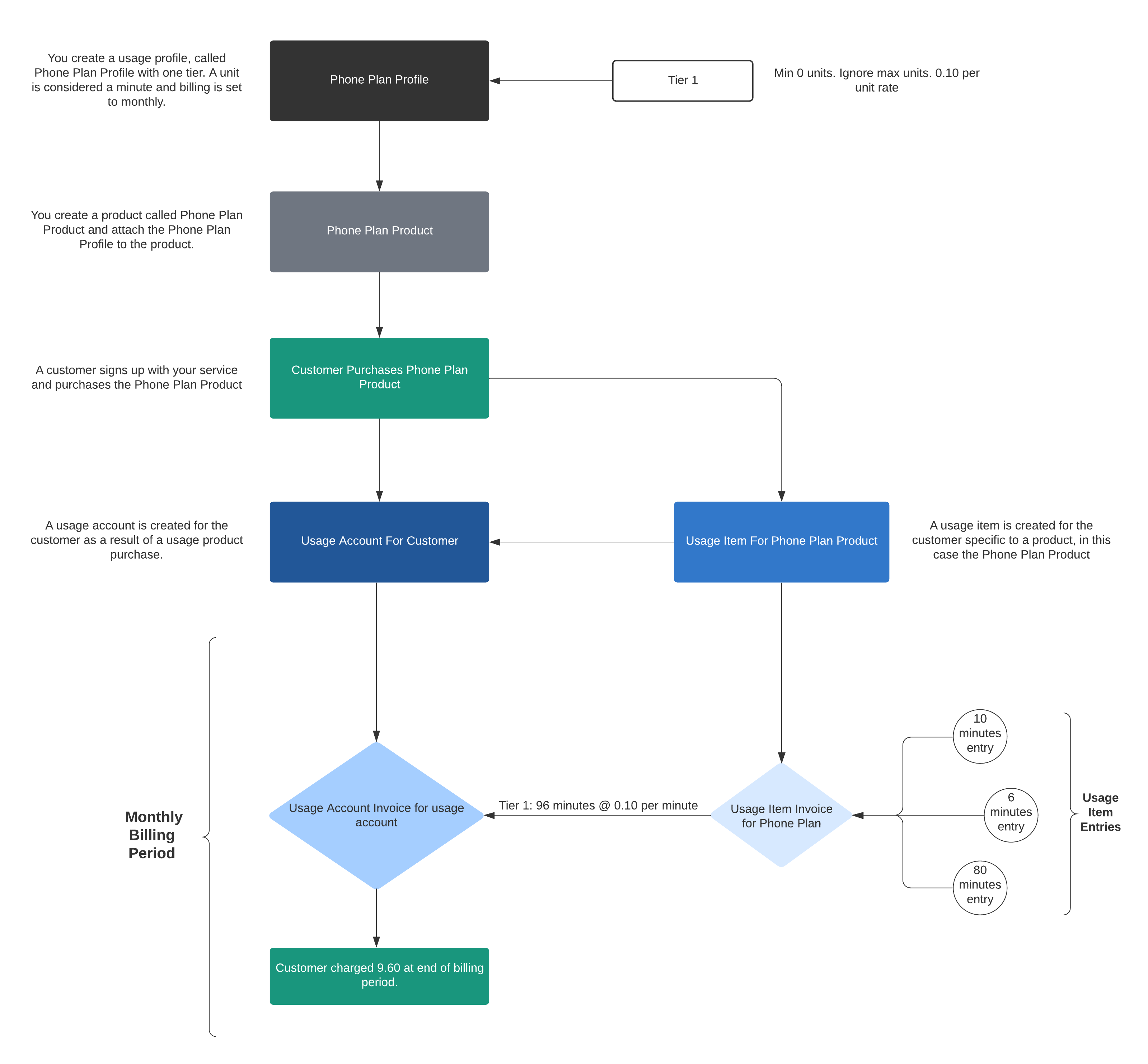
¶ Video Streaming with Overage
This is an example of a video streaming service. You sell the first 100 minutes of streaming for a flat rate of 50. You charge 0.10 for each additional minute of streaming after 100 minutes. A two tiered usage profile would be created. The first tier would be 0 min and 100 max unit range at a flat rate of 50. The second tier would be a 101 min and ignoring max at a 0.10 per unit rate. During the month you submit usage item entries for a duration of the video streaming in minutes, as frequently as you wish.
Once the customer exceeds the tier 1 100 minutes, tier 2 begins and each minutes is 0.10.
If the customer didn't exceed 100 minutes, they would be charged the flat rate of 50.
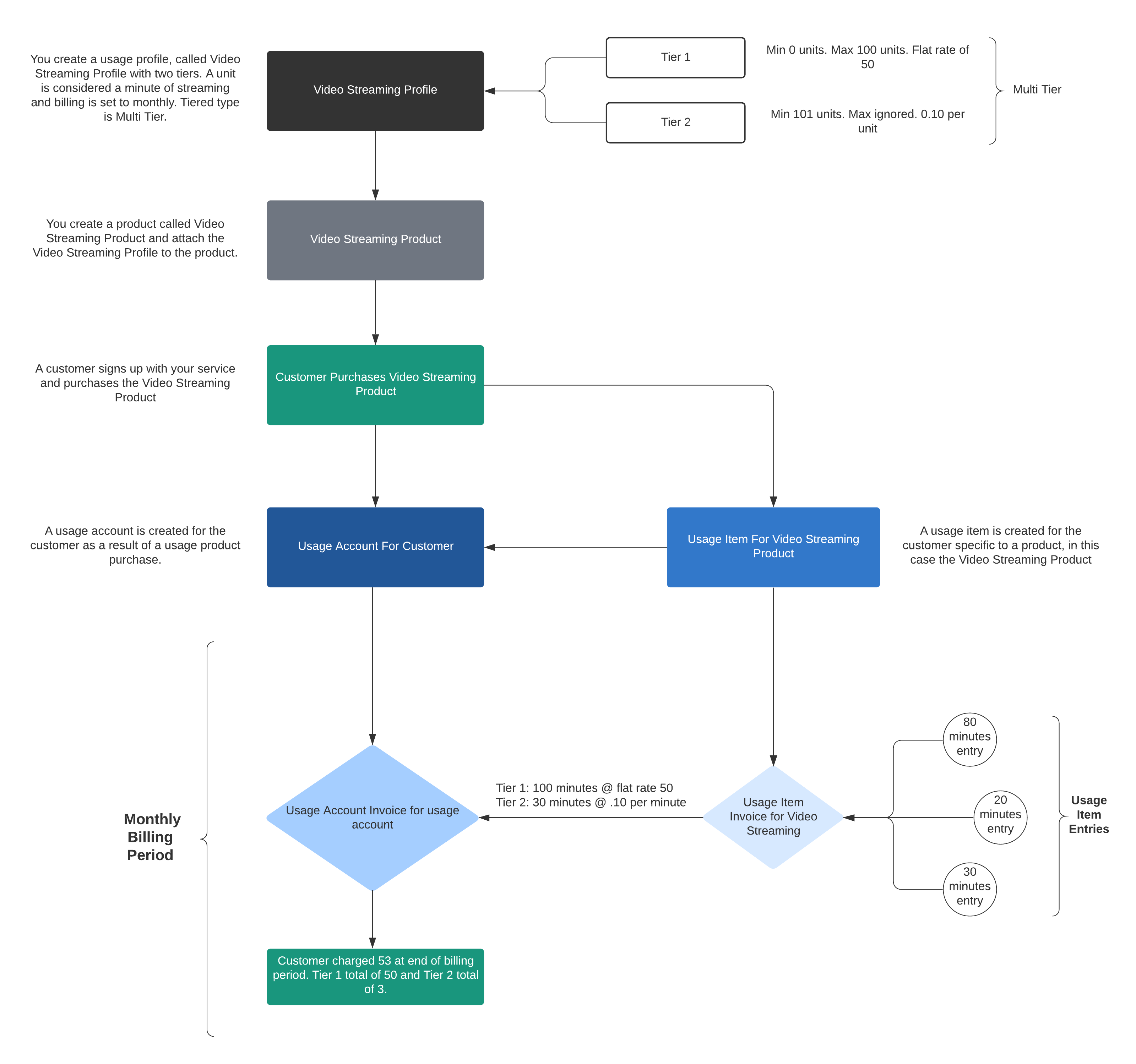
¶ Server Rental & Data Transfer
This is an example of two usage products sold to a customer on a monthly billing schedule. During the month you submit usage item entries for a duration of server rental in hours at any frequency you wish. You also submit separate usage item entries for GB data transferred at any frequency you wish.
- Hourly server rental product which offers a per unit rate of 0.20 per hour.
- Data transfer product which offers free data transfer for the first 100 GB and 0.10 for each additional GB thereafter.
